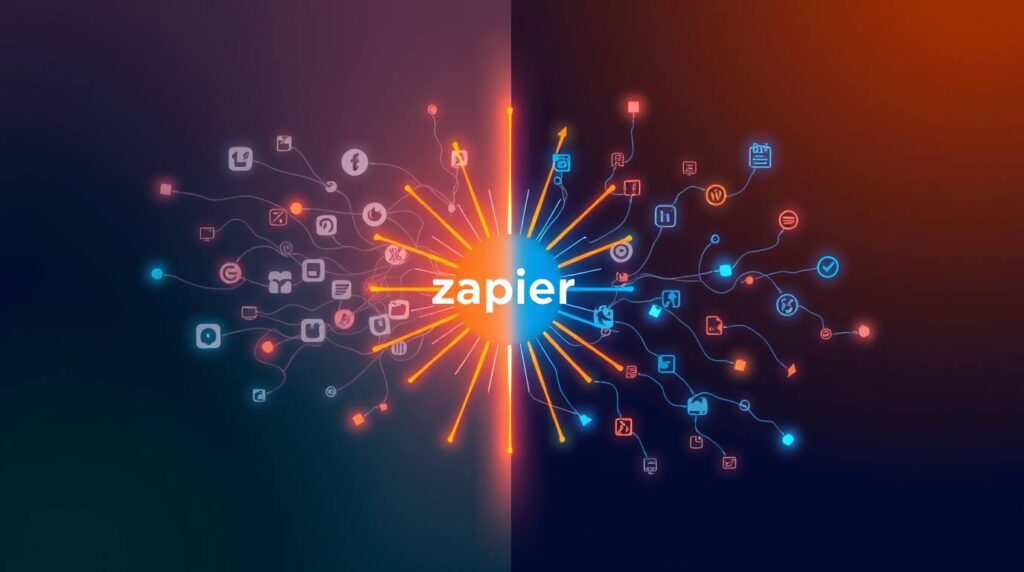⚡ The Data Deluge Dilemma: Why Automation Isn’t Enough Anymore
Picture this: Your sales team logs leads in HubSpot. Support tickets flood in from Zendesk. Marketing metrics pile up in Google Sheets. These apps should talk to each other—but instead, they’re isolated data silos. Manually bridging them wastes 20+ hours per week. Enter Zapier, the automation pioneer now supercharged with AI. With 1.3 million+ companies using Zapier’s AI tools, automation has evolved from simple “if-this-then-that” into an intelligent orchestration layer.
What makes this revolution urgent? Data volume is exploding, but human bandwidth isn’t. Zapier’s latest AI features—like autonomous Agents, no-code AI steps, and Copilot—don’t just move data; they understand it.
⚙️ How Zapier’s AI Tools Transform Raw Data into Action
1. The AI-Powered Zap Builder: Automation in Plain English
Gone are the days of wrestling with triggers and filters. Describe your goal like, “Summarize Slack threads every Friday and email recaps to managers,” and Zapier drafts the workflow in seconds.
- Why it shines: Ideal for simple, repetitive tasks (e.g., sending form responses to spreadsheets).
- Limitation: Struggles with multi-branch logic (e.g., tagging leads only during business hours), requiring manual tweaks.
2. AI Copilot: Your Real-Time Automation Coach
This sidebar assistant troubleshoots errors, suggests dynamic fields (e.g., inserting a contact’s name from Mailchimp), and explains technical hiccups in plain language. One tester called it “Clippy, but actually useful”.
3. Formatter + AI: Fix Messy Data Automatically
Split names, clean dates, or reformat currencies between app steps. Example: Turning “Hi Calvin Biggs” into “Hi Calvin” for personalized emails.
4. AI by Zapier (Prompt Step): Generative Power Inside Workflows
Insert custom AI prompts into Zaps:
- Analyze customer feedback from Typeform and generate tailored responses.
- Summarize support tickets, then route high-priority issues to Slack.
5. Zapier Agents: Your Superhuman Teammates 💡
Agents handle multi-step tasks autonomously:
“Prep sales briefs by pulling calendar invites, researching clients via LinkedIn, and drafting Google Docs.”
- Real-world impact: Remote.com IT team automated 28% of ticket resolutions using Agents, letting 3 people support 1,700 employees.
- Key strength: Live data sync with apps like Notion or HubSpot.
6. Chatbots: 24/7 Customer Problem-Solvers
Train chatbots on help docs, FAQs, or internal databases. They resolve routine queries (e.g., “Track my order”) and escalate complex issues to humans. Learn It Live reduced support tickets by 40% in under an hour.
Table: Comparing Zapier’s Core AI Tools
| Tool | Best For | Complexity | Setup Time |
| AI Zap Builder | Simple task automation | Low | < 5 minutes |
| AI Agents | Multi-step research/actions | High | 10-15 minutes |
| AI Chatbots | Customer-facing interactions | Medium | 5-10 minutes |
| AI Prompt Steps | Custom text/data generation | Medium | 2-5 minutes |
🔥 Real-World Impact: Where AI Automation Drives Breakthroughs
- Sales: Gong call recordings → AI summaries → HubSpot updates. Saves 15 minutes per deal.
- Marketing: AI analyzes Typeform survey sentiments, tags feedback (+/-/neutral), and posts trends to Slack.
- HR: Automate onboarding surveys, translate training materials into 10+ languages via ChatGPT, and sync attendance data.
- Content: AI drafts blog outlines from research, checks SEO gaps, and publishes to CMS platforms.
Table: Industry-Specific Use Cases
| Industry | Problem Solved | Zapier + AI Workflow |
| IT Support | High ticket volume delays responses | Chatbots → Auto-tag → Route to Slack/Teams |
| E-commerce | Poor post-purchase communication | Shopify → AI-generated shipping alerts → SMS |
| SaaS | Lead enrichment delays | Webhook → AI research → CRM update |
🚀 Why This Matters: Beyond Time Savings
Zapier’s AI isn’t just efficiency—it’s strategic leverage:
- Democratization: Non-technical teams build AI workflows.
- Scalability: Handle 10x data volume without hiring.
- Adaptability: Update workflows via prompts vs. code.
- Insight Generation: AI spots trends in data (e.g., churn risks in support tickets).
“Zapier makes our team of three feel like ten.”
—Marcus Saito, Head of IT & AI Automation, Remote
⚠️ Navigating the Pitfalls
- Pricing: AI features (Agents, Chatbots, Tables) add cost layers. No unified bundle yet.
- Complexity Ceiling: Agents falter with adaptive decision-making (e.g., dynamic budget reallocations).
Testing Is Essential: AI outputs vary (non-determinism). Always validate results.
✅ Implementing Zapier + AI: 4 Pro Tips
- Start Simple: Use the AI Zap Builder for linear tasks before deploying Agents.
- Feed Clean Data: Use Formatter to sanitize inputs before AI steps.
- Govern Access: Enterprise plans offer SSO, audit logs, and role-based controls.
- Iterate with Prompts: Save successful AI prompts as templates for consistency.
🌟 Conclusion: The Future Is Orchestrated
Zapier has shifted from automation to AI orchestration—connecting apps, data, and intelligence into a cohesive system. It’s not about replacing humans; it’s about amplifying their impact. As one user put it: “Zapier proves the impossible is possible”.
🚀 Your Turn: Try Zapier’s free tier. Build an Agent to summarize daily Slack threads or a Chatbot for FAQs. Share your breakthrough in the comments!
👉 Explore AI Workflow Templates : Zapier’s AI Use Cases
👉 More Artificial Intelligence Tools – Click here!




